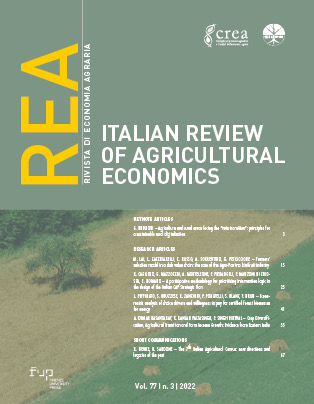Published 2022-11-25
Keywords
- Club varieties,
- kiwifruit,
- farmers’ selection,
- innovation adoption,
- value chains
How to Cite
Funding data
Abstract
Club varieties are protected horticultural varieties that farmers can grow only with the agreement of the intellectual property right holder (breeder). They contribute to the development of vertically coordinated value chains where breeders act as leading firms, because they can control both production and marketing of the protected variety. Despite the breeders’ bargaining power, farmers find club contractual conditions more favourable than those usually offered for non-patented varieties. We hypothesize that breeders may have no incentive to contract all interested farmers in order to avoid expanding production and take advantage of the legal monopoly granted by current regulations. Thus, breeders are expected to select farmers according to an efficiency criterion instead of just licensing all applying farmers. Empirical results from the Agro-Pontino kiwifruit industry support this hypothesis. The results of a questionnaire, submitted to farmers, and of semi-structured interviews targeting key actors of the kiwifruit supply chains, confirmed the selection hypothesis and allow possible selection criteria applied to identify growers of yellow-flesh kiwifruit to be found. A logit-regression model was run using the questionnaire results, while information collected through the semi-structured interviews guided the identification of variables to be included in the model as well as interpretation of the results.
Downloads
References
- Ajzen I. (1985). From intentions to actions: A theory of planned behavior. In: Kuhl, J., Beckmann J. (eds): Action Control. SSSP Springer Series in Social Psychology. Springer, Berlin, Heidelberg. 11-39. DOI: https://doi.org/10.1007/978-3-642-69746-3_2
- Buchanan J.M. (1965). An Economic Theory of Clubs. Economica, 32(125): 1. DOI: https://doi.org/10.2307/2552442
- Dey P.K., Bhattacharya A., Ho W. (2015). Strategic supplier performance evaluation: A case-based action research of a UK manufacturing organisation. International Journal of Production Economics, 166: 192-214. DOI: https://doi.org/10.1016/j.ijpe.2014.09.021
- Di Fonzo A., Nardone V., Fathinejad N., Russo C. (2019). The impact of plant variety protection regulations on the governance of agri-food value chains. Social Sciences, 8(3): 1-14, 91. DOI: https://doi.org/10.3390/socsci8030091
- Edwards-Jones G. (2006). Modelling farmer decision-making: Concepts, progress and challenges. Animal Science, 82(6): 783-790. DOI: https://doi.org/10.1017/ASC2006112
- Lee J., Gereffi G., Beauvais J. (2012). Global value chains and agrifood standards: Challenges and possibilities for smallholders in developing countries. Proceedings of the National Academy of Sciences of the United States of America, 109(31): 12326-12331. DOI: https://doi.org/10.1073/pnas.0913714108
- Legun K.A. (2015). Club apples: a biology of markets built on the social life of variety. Economy and Society, 44(2): 293-315. DOI: https://doi.org/10.1080/03085147.2015.1013743.
- Liu F.H.F., Hai H.L. (2005). The voting analytic hierarchy process method for selecting supplier. International Journal of Production Economics, 97(3): 308-317. DOI: https://doi.org/10.1016/j.ijpe.2004.09.005
- Noleppa S. (2016). The economic, social and environmental value of plant breeding in the European Union: An ex post evaluation and ex ante assessment. HFFA Research. Paper 03/2016 Berlin, February 2016
- Rogers E.M. (1962). Diffusion of Innovations. The Free Press, New York, USA. ISBN 0-02-926650-5
- Russo C. (2020). Pass-Through of Unfair Trading Practices in EU Food Supply Chains Methodology and Empirical Application. Publications Office of the European Union, Luxembourg, 2020, ISBN 978-92-76-19668-6. DOI: 10.2760/837579, JRC120994
- Sansavini S., Guerra W. (2015). Si allarga la filiera distributiva delle varietà brevettate. Rivista Di Frutticoltura, 7(11): 8-18
- Spence M. (1973). Job Market Signaling. The Quarterly Journal of Economics, 87(3): 355-374. Oxford University Press. DOI: https://doi.org/10.2307/1882010
- Talluri S., Narasimhan R., Nair A. (2006). Vendor performance with supply risk: A chance-constrained DEA approach. International Journal of Production Economics, 100(2): 212-222. DOI: https://doi.org/10.1016/j.ijpe.2004.11.012
- Sandler T., Tschirhart J.T. (1980). The Economic Theory of Clubs: An Evaluative Survey. Journal of Economic Literature, 18(4): 1481-1521. http://www.jstor.org/stable/2724059
- Tripp R., Louwaars N., Eaton D. (2007). Plant variety protection in developing countries. A report from the field. Food Policy, 32(3): 354-371. DOI: https://doi.org/10.1016/j.foodpol.2006.09.003


